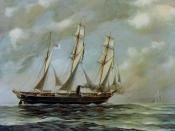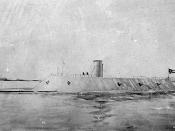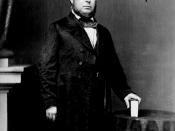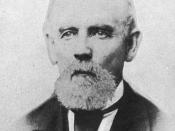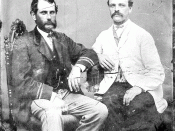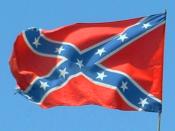Why did the Union Navy defeat the Confederate Navy? What battles took place and why were they unable to do as well as the Union? The Confederate Navy, what navy? A country is formed in about two months and you expect them to have a navy. Well, they did have a navy consisting of 10 ships. Most of these ships were the Unions and they were captured when the southern states seceded. The entire Confederate Navy had only 15 guns when it was formed. The Union Navy had a slight advantage, they had 90 ships, but 21 were unfit for duty, 27 were in need of repairs and 28 were in foreign docks. The Union Navy had only 14 sea worthy ships.
Stephen R. Mallory was appointed Secretary of the Navy on February 21, 1861. He immediately began to form a navy. He signed onto countless number of contracts. A majority were for gunboats to help defend the rivers.
Several of the ships were burned due to lack of good engines. The working engines were saved for the ironclads and the bigger ships. Secretary Mallory knew wooden ships were antiqued and would soon be replaced. He spent the majority of their budget on buying ironclads from the British and constructing some in the south. The lack of manufacturing facilities hurt the confederates. There were only 3 iron factories in the South. They could not maintain manufacturing pace with the North. They had several factories up and down its coasts. Also the South had not yet unified the railroad system, unlike its counterpart, the North. Transportation delays lengthened the time for supplies to reach their manufacturing facilities.
Secretary Mallory, with the capture of the USS Merrimac, began building his first ironclad. Along with the newly named CSS Virginia, work began on four other ironclad ships. The architect behind the ships was John L. Porter. He had great plans for this navy, but due to lack of supplies, lack of skilled labor and the amount of time it took to transport the materials, he was unable to do everything he wanted to. The Merrimac was raised in about a month, but the materials to build it did not come until 8 months later. The CSS Virginia had five guns on her. She was to light and she was enormously slow. She could do a 180 turn in about 40 minutes. She then turned to destroy the blockade at Hampton Roads. She sunk two ships and hurt a third. In return, the Virginia took minimal to no damage. Just when she was going to finish the job, the Monitor showed up and protected the other ships. The ships fought for several hours, but neither was seriously damaged. Eventually, the Virginia had to retire due to the rising tide. Her crew was forced to scuttle or rip a hole in her, because her homeport was captured. They were afraid that the Union fleet would surround and capture the ship. The loss of the South's only ironclad was enormous, but four new ironclads were in the late stages of development. Secretary Mallory and the rest of the South knew it was going to be hard to keep up with the North and if they got European powers to intervene with the blockade and provide support, they would have a chance.
1860 was a very good year for agricultural in the South. Their crops were healthier and more plentiful. This was somewhat of a double-edged sword. The farmers were richer, had more food to use and this helped. They had more product to export to the European countries. When the war started, the European countries, which the confederate navy severely depended on, were satisfied. This meant that going to war to help the South was not an immediate idea and that the countries could have waited to the next harvest, feeling very little loss in their economics. Most, if not all, felt the war would be over within months.
The man, Secretary Mallory hired to get help from these countries was Commander James Dunwoody Bulloch. He had three goals. First, he was to get, by any means, cruisers. These cruisers then would bother the commerce ships of the Union and force the Union to send ships and some men to hunt down these ships. This would intern help keep the Union ships from outnumbering the Confederates. Secondly, he needed to establish a new port to build new ships in foreign countries. These ships would come out of nowhere and raid the blockading ships and the outbound merchant ships. Last, he needed to form a company of blockade runners owned by the government and operated by navy personal. This would help the South get vital supplies to the South and help the war effort. Also the military personal would be very skilled and be able to run the blockade more effectively. Commander Bulloch tried his best to achieve these objectives, but he was unsuccessful because of the immense difficulty the South had to bear.
He did a good job of carrying out his first order of business. The CSS Alabama, CSS Florida, and the CSS Shenandoah were all great at raiding. The CSS Alabama captured about 60 prizes valued around $6,000,000. Also the CSS Florida got 20 ships and the CSS Shenandoah got about 40 even though 2/3 of them were after the war was over. Due to the great work of the confederate raiders, Union commerce was hurt.
Due to the slow railroads and the lack of materials, the South was forced to try to build or get ironclads to be built for them in foreign ports. Secretary Mallory tried to buy ironclads from the European powers, similar to his attempt to buy Glorie, an ironclad made by the French. In the end, the only ironclad made by a European power, to be received by the Confederacy was the Stonewall. It broke down several times on its way to America and as soon as it arrival, it was surrendered to the Union. One thing Commander Bulloch did to help, was he got the Fingal to load up with supplies in England and sail to Savannah, Georgia. It was easily able to get through the blockade and once it reached Savannah, it became the CSS Atlanta.
The Confederate States were being choked to death and blockade running was their only life support. The Confederacy needed food and material for weapons. They should have taken over all blockade runners so that they would get the most needed goods. Instead of doing this, they let businesses control blockade running. These businesses loaded their ships with goods that would make the most money, not what would help the most. This hurt the Confederacy and the whole war effect. Instead of getting food that people could eat, they got salt and coffee.
George Alfred Trenholm was one half of the ownership of the most successful blockade running firm. It was Fraiser Trenholm. His firm anticipated the war a year before and establish a branch in Liverpool. They recruited Charles Prioleau, he was naturalized British. They hoped this would get the British to provide some help. He was also the manager of the Liverpool house. They greatly helped the South. Unlike most other firms, Fraiser Trenholm was not all about money, most of their cargo was war related. Once a huge cargo arrived in middle of the night and helped to equip 10,000 soldiers. A battle happened the next day and wagons of supplies were moving the entire next day.
Blockade running was easy to do when the war began, because the Union had very few ships to control the coast. During the first year one out of every nine were caught and during the second year one out of seven. Then in 1863, your odds were one in four. When supplies did arrive, they were at smaller ports, the supplies had to be shipped to other areas and the lack of a uniform railroad again hurt the confederacy.
Blockade running was very profitable. The profits on a single cargo were 1500%. Inflation in the South rose to 900%. The price of a ton of salt rose from $6.50 to $1,700 and a ton of coffee from $249 to $5,500. The blockade running could have been more successful if the navy was able to keep its own.
The navy exerted a major effort, but it could not keep up with the Union. So the Confederate Navy had to try something else, trickery. The South had submarines, mines, and Davids. A David resembled a submarine but was a floating vessel. It had an explosive charge attached to the end of a spar, it was cigar-shaped. It had been designed to take out the goliath of the North's navy, USS New Ironsides. October 5, 1863, David rammed New Ironsides with the explosive charge and seriously damaged it. David is a generic term for boats of this type and there is no number of how many there where. But after October 5, Davids attacked along the blockade, with their explosives and mines. The mines were sometimes nothing but wooden kegs with explosives inside. Some could be triggered from shore. The mines played a great deal in many navy battles, especially the battle of Mobile, Alabama.
One problem the South had, was the Army and the Navy never could agree and ended up differing on various subjects. The Army had the good rail lines forcing supplies to take forever to reach their destination in the Navy. Also the Navy destroyed railroad to make ironclads. The Army used nearly all the skilled workers, leaving few for the Navy, a major reason why their ships were inferior and needed constant repair. Also the Army ranked over the navy. In the west, one of the many reasons the Confederate Army came up on the losing side was that the Navy was exceptionally small, and sometimes the Confederate Army had to fight the Union Army and Navy.
Their river defense was sub-standard due to the lack of gunboats. Gunboats were hard to make because the good engines the South had, they used on the ironclads. Secondly, the ironclads were unable to patrol or defend the rivers because of their shallowness. The Mississippi River was one of the strategic points in the war. The South lost New Orleans in April, 1862. Then came the siege of Vicksburg, which ended around July, 1863. The loss of the Mississippi cut the Confederacy and signaled the doom of it.
The lack of iron and engines to fulfill the orders for gunboats, and ironclads, might alone have signaled the defeat of the Confederate Navy. If not, then the shortage of skilled labor, materials needed to build quality ships, and the emerging Union Navy, in no doubt crippled the Confederate Navy.
The new technology significantly helped their navy compete with the Union, but it was not enough. Most of the major battles were fought between two or three Confederate ships and 12 to 15 Union ships. Almost all battles were short and had very little impact. This three monumental battles lead to the demise of the Confederacy. They are the battles of Vicksburg, Mobile and the duel of the Alabama and the Kearsarge, and all there were Union victories.
The fall of Vicksburg left the Mississippi to the Union. It also could have been the straw that broke the donkey's back. As the Union continued to take win more and more battles along the Mississippi, both the North and the South focus their attention towards Vicksburg. It was above the river, which allowed it troops from inside the city to attack, but at the same time prevent river attacks. Two rams guarded the river by Vicksburg. Farragut, the Union Commander, ordered an attack on Vicksburg. The Union fleet attacked and lost the battle and the USS Indianola. Farragut then came up with a plan to float a phony ironclad, which would then distract the two ships. The plan worked perfectly and the Union Navy gained control of the port. Twice, the confederates were tricked. First they chased the dummy and secondly, they raised the USS Indianola and burned her at the sight of the dummy, because they thought it would try to capture her back. This cost the Confederates a major port, which they could have held, quite possibly, for a long time. They would have had three ships. The USS Indianola was an ironclad, and I am guessing the other two were ironclads also. Three ironclads in a port are extremely hard to overcome, and they might have kept the port in Confederate control for the duration of the war.
